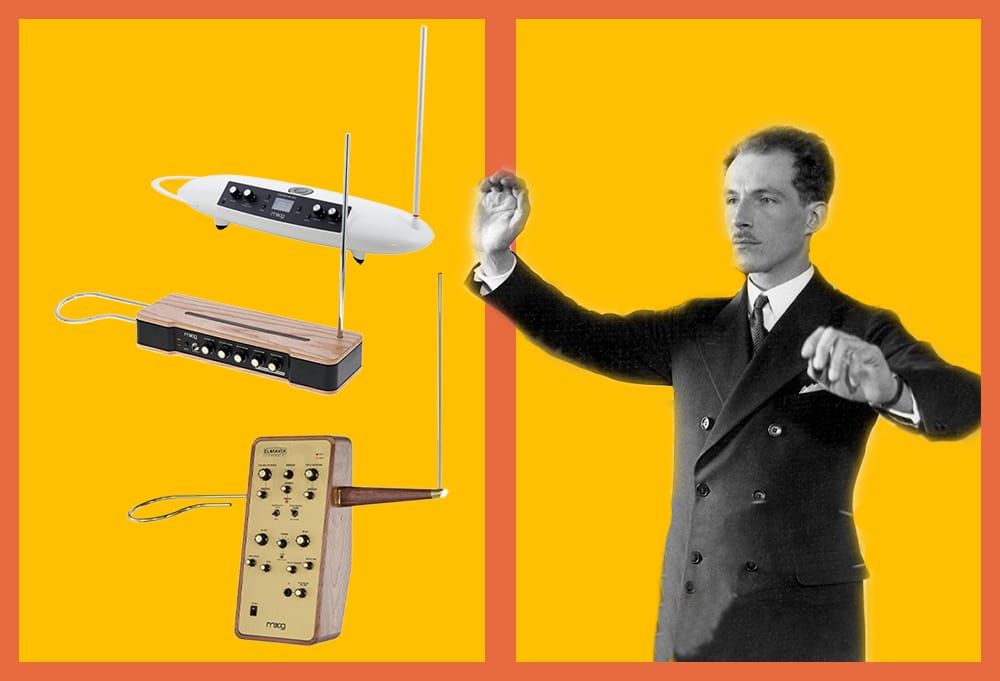Have you ever seen this strange instrument that looks like something out of a science fiction movie?
The musician stands in front of a "box" with two long antennae and moves his hands to produce sounds.
This electronic instrument is called the theremin and is the very first synthesizer ever invented.
The sound is often described as eerie, alien or spooky and reminds some of a fragile female voice.
This invention paved the way for the world of electronic synthesizers, which have become an indispensable part of modern music.
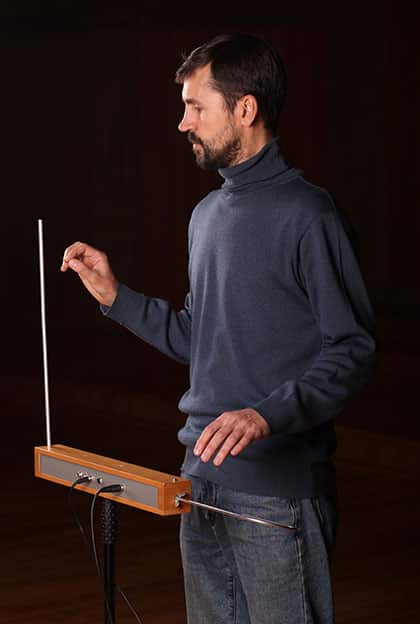
Also interesting: Balalaika: History, Variations and Use
What is a Theremin?
The theremin is an electronic musical instrument (the oldest known) in which the musician has no physical contact with the instrument. This electronic instrument is controlled via 2 antennas by the distance of both hands. One hand controls the volume (via the volume antenna) and the other the pitch (via the pitch antenna).
It was invented in 1919 by the Soviet physicist Lev Sergeevič Termen (known in the West as Léon Theremin or Theremine) and is based on oscillators operating in isofrequencies outside the audible spectrum.
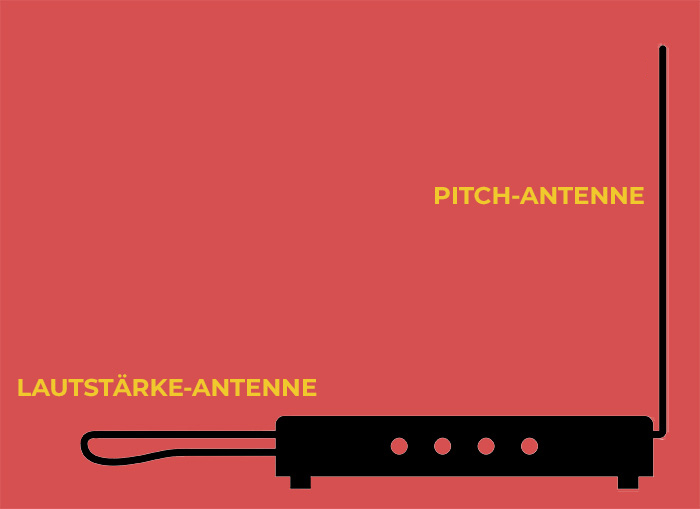
How does a Theremin work?
The core of this instrument consists of two oscillators that work in unison: The sound generation is based on the physical principle that the waves generated by the two devices beat together.
The frequency produced by each of the two oscillators is outside the audible spectrum (above 20kHz); the instrument produces no sound at rest because there is no frequency difference.
By connecting an antenna to the capacitor of one of the two oscillators, it is possible to change its capacitive component and thus its working frequency by simply bringing an obstacle (usually the hand) closer or further away from the antenna; the frequency shift thus produced consequently creates a beat (this is what this phenomenon is called in physics), which leads to a third wave.
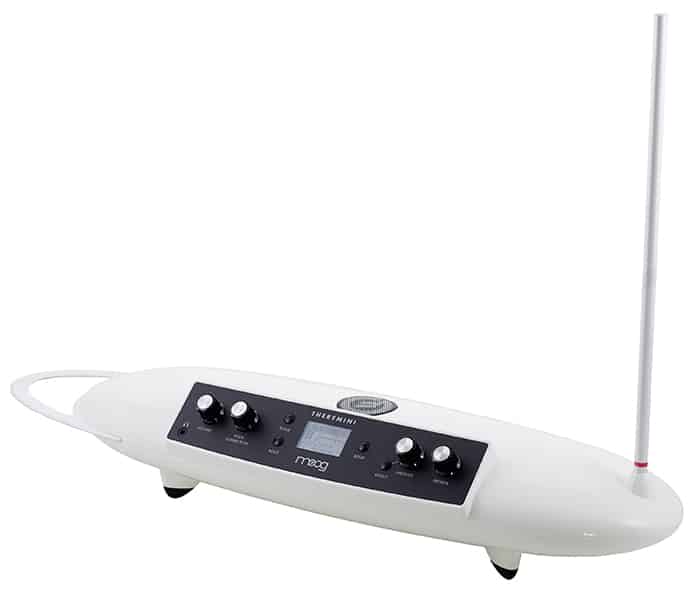
The Theremin's oscillators are designed so that the variable capacitance oscillator's frequency shifts are between 20 and 20,000 hertz, creating a third beat wave that stays within the audible sound spectrum.
The sound signal thus generated is passed directly to a speaker or, depending on the design of the instrument, to an amplifier stage and then to speakers. The new versions of the theremin also contain a second electronic stage similar to the first (volume antenna)
This is a transducer that converts the beat frequency into an electrical voltage; the sound produced by the first stage is then damped in relation to the voltage produced by the second stage to make the instrument dynamic and allow the player to vary the intensity and volume of the sound by working with the other hand near another antenna.
Keep reading: What is a vocoder? Functionality, history and best models
Use of the theremin
Thanks to its characteristic sound, which oscillates between the futuristic and the uncanny, the theremin has also been used in numerous film scores, especially for science fiction, horror and thriller films, including James Whale's The Bride of Frankenstein, Alfred Hitchcock's I'll Save You and Robert Wise's The Day the Earth Stood Still.
Other well-known examples are the opening melody for the animated films Scooby-Doo and Ben 10 and the theme tune for the television series Inspector Barnaby and ESP. In 1982, Michael Jackson and his musicians made extensive use of it in the creation of one of his most famous songs, Thriller.

By loading the video, you accept YouTube's privacy policy.
Learn more
History of theremin
Leon Theremin got the idea for the instrument when he was conducting experiments in the laboratory with devices he had developed himself to measure the density of gases in a vacuum.
He soon noticed that, under certain conditions, a whistling sound was produced that changed in frequency the closer or further he moved his hand from the circuits.
He developed the idea to the point of building a real musical instrument, and at the time he called it the heterophone.
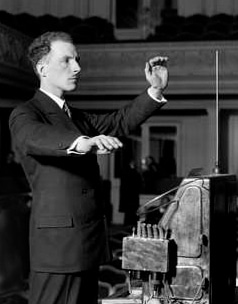
Termen was also a musician (cellist) and took advantage of the musical communities he frequented to publicize his invention, which met with great interest. Some time later, Lenin proposed to spread the instrument throughout Europe.
A tour of the main European capitals was organised: Berlin, London and Paris. In Paris, curiosity caused riots among the thousands of people who had not managed to get a seat in the theatre.
In 1928 Termen landed in New York, where the instrument was presented to a small group of musicians and industrial magnates. As a result, a company was founded to develop and build the heterophone which was then named theremin .
The commercial building rights were later given to RCA, but due to the economic crisis in those years, the selling price was so high that it wasn't affordable for the majority of people.
The instrument's greatest virtuoso was Clara Rockmore, a violinist born in Lithuania and naturalised in the United States, who was unable to continue her practice for health reasons and devoted herself to the new instrument.

By loading the video, you accept YouTube's privacy policy.
Learn more
In 1982, Michael Jackson used this instrument for the famous song Thriller. Tobias Sammet, bandleader and composer of the German heavy metal band Edguy, included a theremin solo in Space Police, a track on the 2014 album Space Police - Defenders of the Crown. Hollywood has also used the theremin several times, in the soundtracks of various films, often science fiction or horror films, to give the film a "space" atmosphere or to emphasise the disturbing scenes.
Robert Moog, the "father" of modular synthesizers, was fascinated by the theremin as a teenager. So much that he built his own one - and started selling the first theremin kits for $50 a few years later.
He was so enthusiastic about it that it later inspired him to invent the modular synthesiser. So we can say that without theremin there would be no modular synthesizers.
Nowadays you can buy 3 different theremin models from Moog, all with many additional features that simplify playing and sound production:
- Moog Theremini (459€)
- Moog Etherwave Theremin (949€)
- Moog Claravox Centennial Theremin (1.599€)
How to play the Theremin?
The theremin is considered an instrument that is easy to learn but extremely difficult to master. Since you don't get any visual feedback, you don't have a board to grab onto, and the exact positions to the pitch change over time, you have to rely on your ear to 100%.
It is also very difficult to play single, distinguishable notes, because here - unlike on the violin - you cannot make the hand suddenly disappear and appear (when playing a violin, you can lift the bow from the string to end the sound). The functional principle of the theremin enforces a continuous change of the pitch.
The people like Lydia Kavina, who really master this instrument, have incredibly good muscle coordination and a very good hearing. The pitch change and volume control sensors are very sensitive - a tiny little movement is enough to change the pitch, and the sound is skewed.
You will definitely need many hours of practice if you want to learn to play the theremin - but it is definitely worth it, because there are relatively few people in the world who have really mastered it. So the competition is less!
Here are 5 tips for you if you decide to buy and learn a theremin:
- Be prepared to practise for many hours. After all, it is the most difficult instrument to master!
- You have to train your hearing. This happens when you practise, but you can improve your hearing even more with certain software or piano exercises.
- Set up a suitable place. Experts say you need at least 1.5m of space in all directions so that no objects interfere with the two antennas.
- One hand after the other. Do not try to play with both hands at the same time in the beginning. Keep the hand that controls the volume in a fixed position and then start practising with the other hand.
- Hold, hold and hold. Another important factor for success in theremin playing is the ability to sustain a note for a long period of time without the pitch or volume fluctuating.
Linearity
People often talk about the linearity of theremin, that is, the ability to keep the intervals between notes constant with the same hand and finger movements. This does not mean linearity in the mathematical sense, but linearity that is consistent with the human senses, including hearing.
The theremin is not linear by nature, or at least not perfectly linear. There are no scalas or no tuning in the classical theremin. The factor of linearity in the acoustic sense is very important, especially in the field of classical music (or indeed anywhere where you want to make a particular melody reproducible).
The difference in quality between one theremin and another often lies precisely in this factor. Among the most acoustically linear theremins are the Moog Etherwave Theremin or the Moog Claravox Centennial Theremin. Most other models have a pitch shift that tends to accelerate as you approach the antenna.
Theremin recommendations
1. Moog Etherwave Theremin
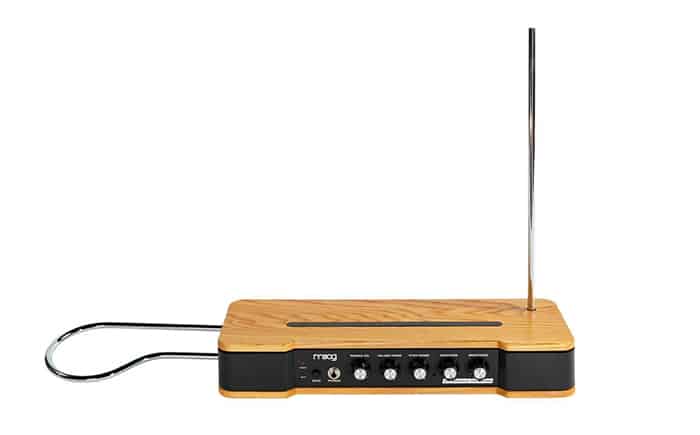
Alongside Leon Theremin, Robert Moog is one of the main people responsible for popularising the theremin. And today, Moog is the best-known manufacturer of this instrument.
The Moog Etherwave is the most popular model. This one has a frequency range of 0Hz to 4.2 kHz and a dynamic range of 70dB, giving you incredible flexibility. You can even limit these ranges with the "Pitch Range" knob and "Volume Range" knob.
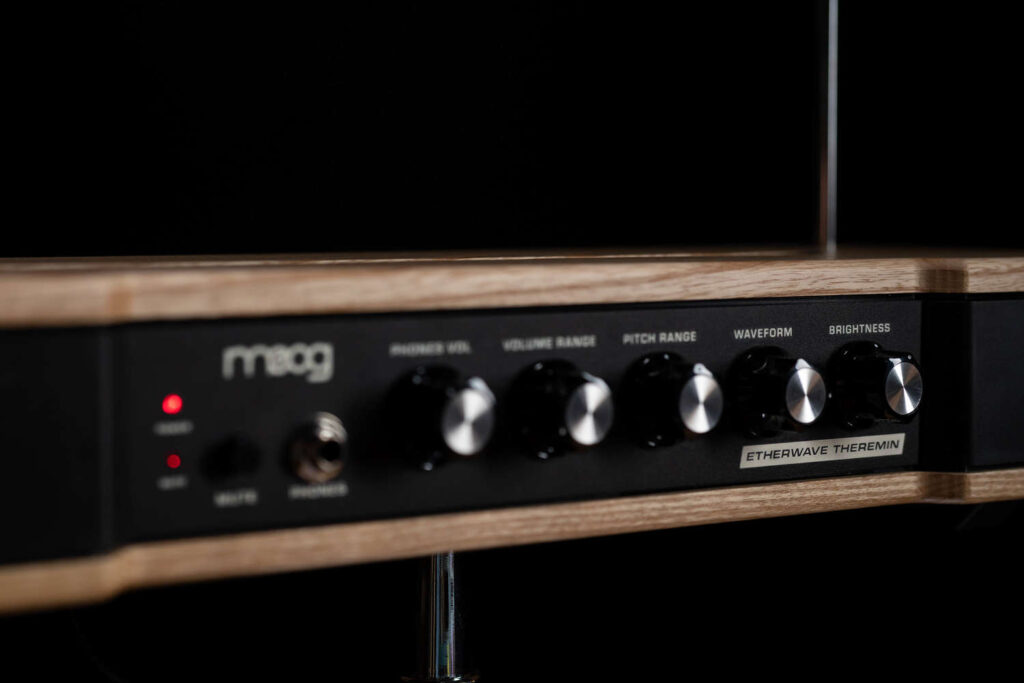
The great thing about modern theremins like this is that you have additional options to customise the sound. With the Moog Etherwave, you can adjust the sound with the "Brightness" and "Waveform" knobs. This gives the musician much more flexibility and sound design possibilities.
In addition, there is a mute switch input to connect a mute pedal - very practical for ending sounds - and CV inputs to control a synthesizer.
Overall, I think this model is really well done - all the additional functions are very practical and useful and make the Theremin a great all-rounder.
Price: 949€, Buy Theremin
2. Moog Theremini
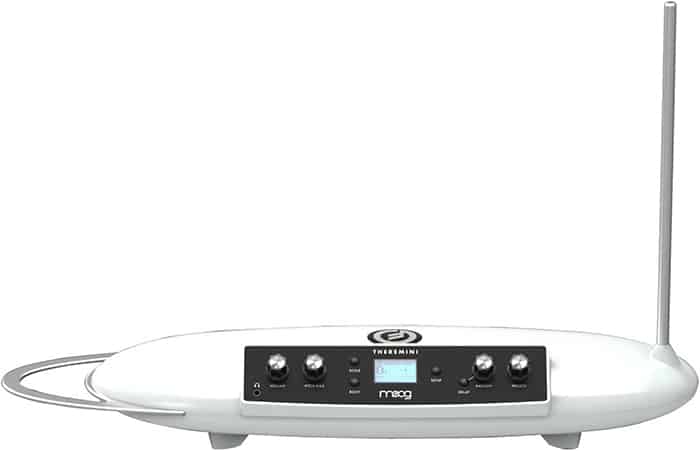
The Moog Theremini is a cheaper model from Moog that is intended for beginners. However, it offers a lot of additional features that the first model does not have.
It has a built-in tuner so you can see exactly which note you're playing in real time. Just right for beginners!
And then there's something really cool called "Assistive Pitch Quantisation" - also known as Auto-Tune for Theremin. This allows you to set scales so that you can only play notes within that scale. You can adjust the "intensity" of this quantisation.
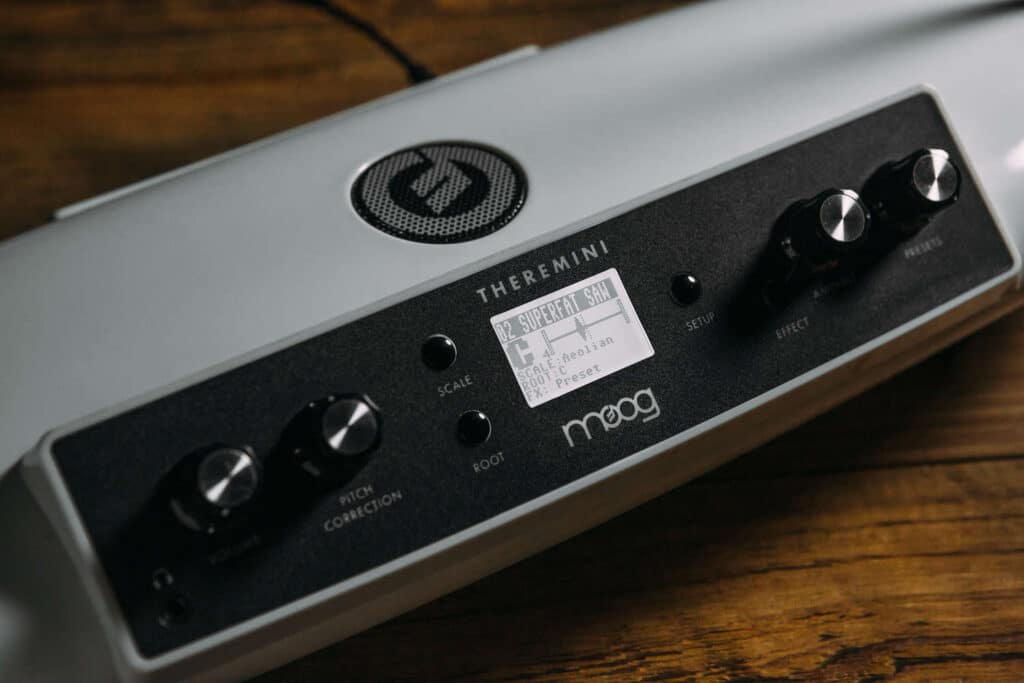
- Maximum: All notes are perfectly in-tune, so you cannot play wrong notes outside the scale.
- Minimum: You are completely free and in full control; the tones are not corrected.
This is especially useful for beginners because you can adjust how much "support" you get while playing. In the beginning, you can set the quantisation higher so that everything sounds decent. And the better you get, the less quantisation you add until you don't need it anymore.
There is also a built-in stereo delay, which gives you more creative options, and a sound bank, where you can save different presets of your settings.
All in all, one can say that this theremin is just right for beginners - especially because of the "Assistive Pitch Quantization". The many other functionalities make this instrument a great, very flexible theremin.
Price: 459€, Buy Theremin
3. Moog Claravox Centennial
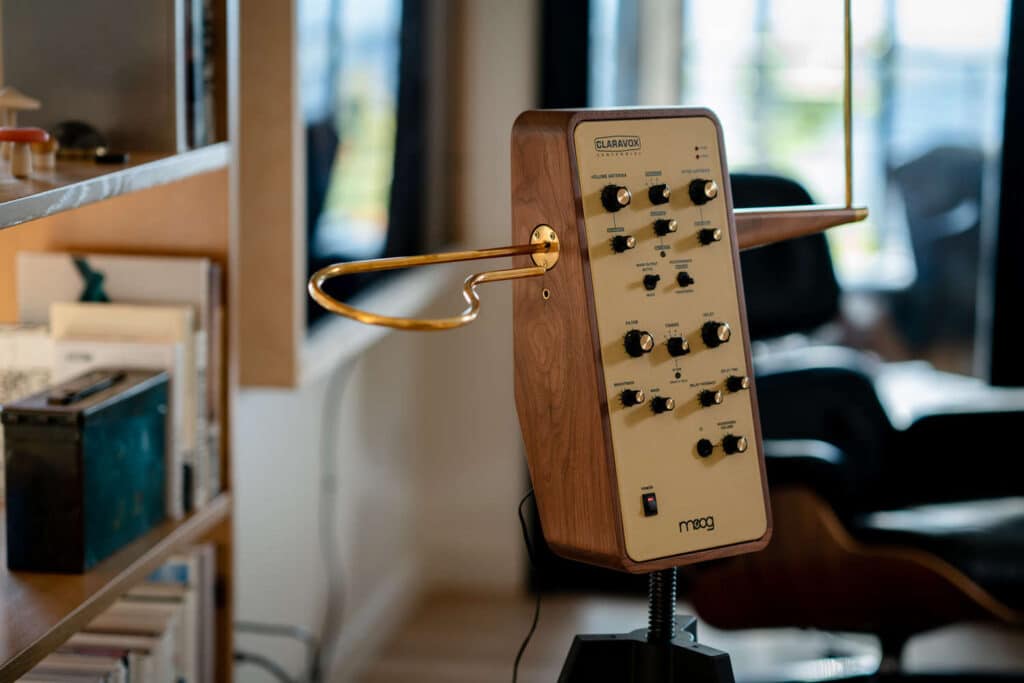
The third model is again from Moog - but not because they pay me to promote their products (that would be nice!). The fact is that there are only a few good manufacturers of this instrument on the market besides Moog.
The Claravox Centennial is Moog's flagship product - which is of course also noticeable in the price (€1,599). It is a limited edition model designed to celebrate the 100th anniversary of the instrument as a tribute to theremin virtuoso Clara Rockmore.
It has a lot of options that you can adjust to change the sound:
- Two modes: Modern and Traditional
- Quantisation of notes in modern mode
- Analog delay
- Filter
- Waveform change
- Brightness Knob
The modern mode behaves similarly to the Theremini: you can select scales and adjust the intensity of the quantisation (pitch correction). As I said, very practical for beginners. But I don't think a beginner will spend so much money on his first theremin.
This theremin has many outputs - especially the volume and pitch outputs are very practical. They allow you to connect it to other modular synthesizers, which opens many doors in sound design.
All in all, one can say that this instrument is rather meant for professionals - after all, it is not exactly cheap. However, many functions are built in here that can make playing quite easy for a beginner.
Price: 1.599€; Buy Theremin
Widara Distant Voices Theremin
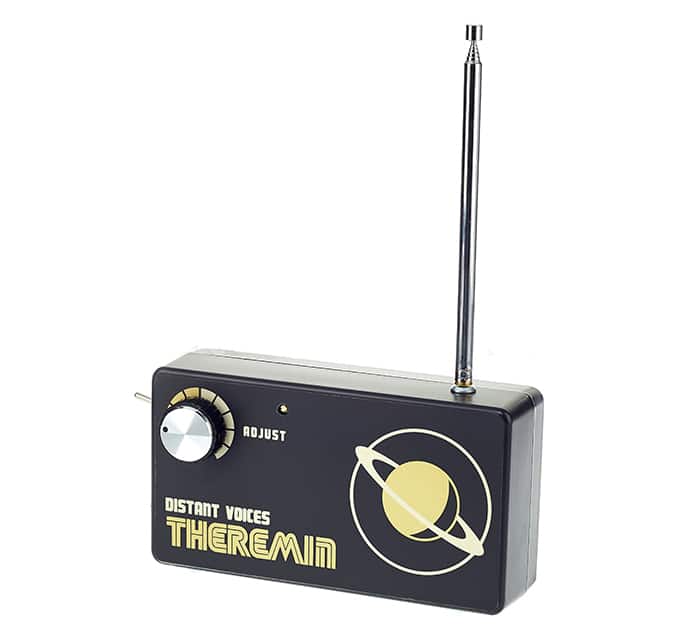
This is a very cheap model with limited capabilities that really shouldn't be compared to the Moogs. However, this theremin is just right if you only want to create a few FX effects with it, which is the case with many producers.
This portable theremin is battery-powered and has no volume antenna, so it's not really suitable for playing as a lead instrument. However, it is designed to be plugged directly into a guitar amp to create wicked sounds on stage or in the studio as an effects unit.
Price: 99€, Buy Theremin
Conclusion
A theremin can be a great addition to your instrument and synthesiser collection. However, you have to be willing to invest a lot of practice hours - which of course is a lot of fun. That's why I advise anyone who is interested and motivated to try it out.





